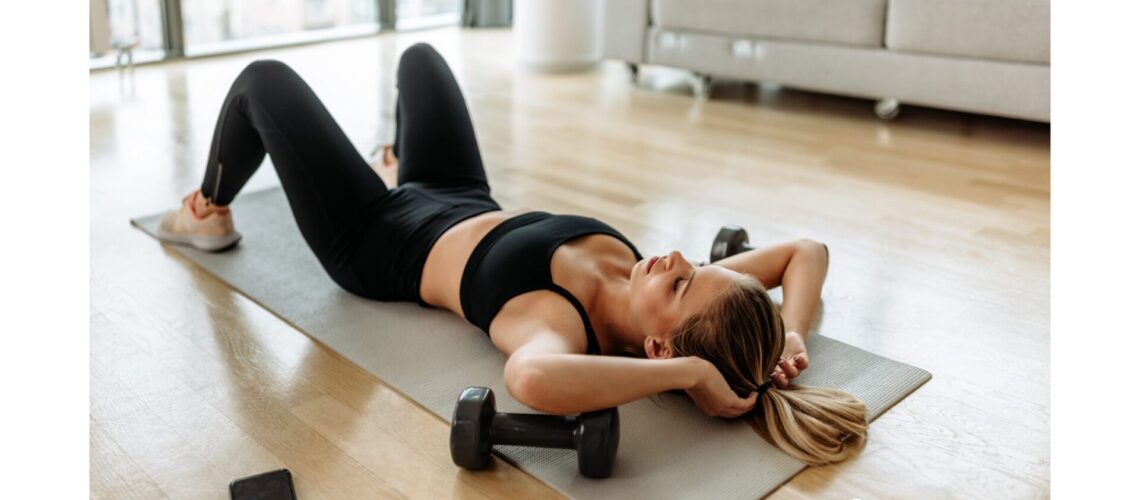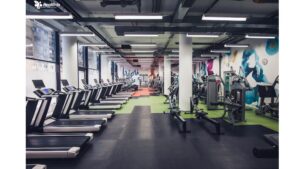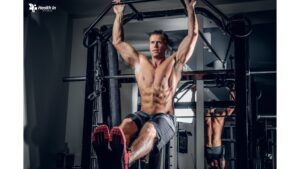
Building full-body strength doesn’t require a gym membership or fancy equipment. With the right exercises and a dedicated routine, you can effectively strengthen your entire body from the comfort of your home. Full-body strength workouts target multiple muscle groups simultaneously, ensuring that you develop functional strength, improve muscle tone, and increase endurance. Use these Effective At-Home Workouts for Full-Body Strength.
In this guide, we’ll break down some of the most effective at-home workouts for full-body strength, with tips on how to structure your routine, maximize your results, and maintain consistency over time. Whether you’re a beginner or an experienced fitness enthusiast, these exercises will help you reach your strength goals without stepping into a gym.
1. Benefits of Full-Body Strength Workouts
Before diving into specific workouts, it’s important to understand why full-body strength training is so effective, especially when done at home.
A. Time-Efficient Workouts
Full-body strength workouts allow you to target all major muscle groups in a single session, making them a time-efficient way to stay fit. Instead of focusing on isolated muscle groups, these workouts engage multiple areas at once, helping you build muscle, burn fat, and improve overall fitness in less time.
B. Functional Strength
Full-body exercises are often compound movements, meaning they mimic the types of movements you perform in everyday activities, like lifting, carrying, and bending. By improving your functional strength, you’ll find daily tasks easier to complete, and you’ll reduce your risk of injury.
C. Increased Calorie Burn
Because full-body workouts engage more muscles, they require more energy, leading to a higher calorie burn both during and after the workout. This can contribute to fat loss and improve body composition over time.
D. Minimal Equipment Required
Many effective full-body strength exercises can be performed using just your body weight or with minimal equipment, such as dumbbells or resistance bands. This makes them perfect for at-home workouts where space and equipment may be limited.
2. At-Home Workouts for Full-Body Strength
The following exercises target multiple muscle groups and can be performed at home with little to no equipment. These moves are designed to build strength, improve endurance, and increase flexibility.
A. Bodyweight Exercises for Full-Body Strength
Bodyweight exercises are some of the most effective ways to build strength without the need for equipment. These exercises can be modified to suit any fitness level, from beginner to advanced.
1. Push-Ups
Push-ups are one of the most basic yet effective exercises for building upper body and core strength. They target the chest, shoulders, triceps, and core muscles.
- How to perform: Begin in a high plank position with your hands placed slightly wider than shoulder-width apart. Keep your body in a straight line from head to heels as you lower your chest toward the floor. Push back up to the starting position.
- Modification: Beginners can modify the push-up by lowering their knees to the ground or performing the push-up against a wall.
- Progression: To make push-ups more challenging, try elevating your feet on a chair or performing explosive push-ups (pushing off the floor with enough force to lift your hands slightly off the ground).
2. Squats
Squats are a fantastic lower-body exercise that strengthens the quads, hamstrings, glutes, and core. They also help improve mobility and stability in the hips and knees.
- How to perform: Stand with your feet hip-width apart and toes pointed slightly outward. Lower your body by bending at the hips and knees, keeping your chest lifted and back straight. Go as low as you can while maintaining good form, then press through your heels to return to the starting position.
- Modification: Beginners can use a chair for support, sitting down on it as they squat and standing back up.
- Progression: To increase difficulty, try jump squats, where you explosively jump from the squat position and land softly into the next squat.
3. Planks
Planks are an excellent full-body exercise, with an emphasis on the core. They also engage the shoulders, back, and legs, helping to build overall strength and stability.
- How to perform: Start in a forearm plank position, with your elbows directly under your shoulders and your body in a straight line from head to heels. Hold this position for as long as possible, maintaining tight core engagement and avoiding sagging hips.
- Modification: Beginners can perform a modified plank by lowering their knees to the ground while still engaging the core.
- Progression: For an extra challenge, try side planks, plank-to-push-ups, or lifting one leg at a time during the plank hold.
4. Lunges
Lunges are a dynamic lower-body exercise that strengthens the quads, glutes, and hamstrings while also improving balance and coordination.
- How to perform: Stand with your feet hip-width apart. Step forward with one leg and lower your body until your front thigh is parallel to the floor and your back knee is just above the ground. Push through your front foot to return to the starting position, then switch legs.
- Modification: For beginners, limit the depth of your lunge or use a wall for support.
- Progression: Increase difficulty by adding a jump between lunges (jump lunges) or holding weights for added resistance.
B. At-Home Workouts with Minimal Equipment
If you have access to basic equipment like dumbbells, kettlebells, or resistance bands, you can take your at-home full-body strength workouts to the next level. Here are a few exercises that utilize minimal equipment but deliver maximum results.
1. Dumbbell Deadlifts
Deadlifts are a powerhouse exercise that strengthens the posterior chain (glutes, hamstrings, and lower back) while also engaging the core and upper body.
- How to perform: Stand with your feet shoulder-width apart, holding a dumbbell in each hand in front of your thighs. Hinge at your hips and lower the dumbbells toward the floor, keeping your back flat and knees slightly bent. Return to the starting position by driving through your heels and extending your hips forward.
- Modification: Beginners can use lighter weights or perform the movement with bodyweight only.
- Progression: Increase the weight of the dumbbells or perform single-leg deadlifts to challenge your balance and stability.
2. Kettlebell Swings
Kettlebell swings are a full-body, high-intensity exercise that strengthens the glutes, hamstrings, core, and shoulders while also providing a cardiovascular challenge.
- How to perform: Stand with your feet shoulder-width apart, holding a kettlebell with both hands in front of you. Hinge at your hips and swing the kettlebell between your legs, then drive through your hips to swing it up to chest height. Keep your core engaged throughout the movement.
- Modification: Start with a lighter kettlebell and focus on mastering the hip hinge movement before progressing to heavier weights.
- Progression: Increase the weight of the kettlebell or perform single-arm kettlebell swings for added difficulty.
3. Resistance Band Rows
Rows are an excellent exercise for building upper-body strength, particularly in the back, shoulders, and arms. Resistance bands are a great tool for simulating rowing movements without needing a gym machine.
- How to perform: Anchor a resistance band to a door or sturdy object at chest height. Hold the ends of the band with both hands and step back to create tension. Pull the band toward your chest, squeezing your shoulder blades together, then slowly return to the starting position.
- Modification: Use a lighter resistance band to make the movement easier.
- Progression: Increase resistance by using a thicker band or performing single-arm rows for a greater challenge.
3. Structuring Your At-Home Full-Body Workout
When performing at-home full-body strength workouts, it’s essential to structure your routine for maximum effectiveness. A well-balanced workout plan should target all major muscle groups and allow for proper recovery between sessions.
A. Warm-Up
Before starting any workout, it’s important to warm up your muscles and get your blood flowing. A good warm-up should include dynamic stretches and movements that mimic the exercises you’ll be performing.
- Example Warm-Up: 5-10 minutes of light cardio (jogging in place, jumping jacks) followed by dynamic stretches like arm circles, leg swings, and hip openers.
B. Full-Body Workout Routine
Here’s a sample full-body workout routine that you can perform at home with minimal equipment. It combines bodyweight exercises and dumbbell movements to provide a balanced, effective workout.
- Push-Ups: 3 sets of 12-15 reps
- Squats: 3 sets of 15-20 reps
- Plank: 3 sets, hold for 30-60 seconds
- Lunges: 3 sets of 12-15 reps per leg
- Dumbbell Deadlifts: 3 sets of 10-12 reps
- Resistance Band Rows: 3 sets of 12-15 reps
C. Cool Down and Stretching
After completing your workout, take time to cool down and stretch your muscles. This helps reduce muscle soreness and improves flexibility.
- Example Cool-Down: 5 minutes of light stretching, focusing on the muscles worked during your session (hamstrings, quads, chest, shoulders, and back).
4. Tips for Maximizing Your At-Home Strength Training Results
Building strength at home is entirely possible with the right mindset and approach. Here are a few tips to help you maximize your results and stay on track with your fitness journey.
A. Stay Consistent
Consistency is key when it comes to building strength. Aim to perform full-body workouts at least 3-4 times per week, with rest days in between to allow for muscle recovery. The more consistent you are, the better your results will be over time.
B. Focus on Form
Proper form is essential to avoid injury and ensure you’re targeting the right muscle groups. Take the time to learn the correct technique for each exercise, and don’t hesitate to modify movements if needed. As you progress, gradually increase the intensity and difficulty of your workouts.
C. Challenge Yourself
To continue building strength, you need to challenge your muscles by increasing the resistance or intensity of your workouts over time. This can be done by adding more repetitions, increasing the weight you’re using, or incorporating more advanced variations of exercises.
D. Track Your Progress
Keeping track of your workouts, including the exercises performed, sets, reps, and weights used, can help you stay motivated and monitor your progress. Seeing improvements in your strength over time is one of the most rewarding aspects of strength training.
5. Advanced At-Home Strength Training Strategies
While the basics of at-home strength training can produce significant results, there are more advanced strategies you can adopt to push past plateaus and continue progressing. By incorporating different types of resistance, using more challenging variations of exercises, and enhancing your mind-muscle connection, you can continually push your body to adapt and grow stronger.
A. Progressive Overload: The Key to Continued Growth
One of the most important principles in strength training is progressive overload. This simply means that in order to build muscle and strength over time, you need to gradually increase the demand on your muscles. Your body adapts to the stress you place on it, so continually adding more challenge is essential for progress.
Here are a few ways to apply progressive overload at home: Effective At-Home Workouts for Full-Body Strength
- Increase Repetitions: One of the easiest ways to apply progressive overload is by gradually increasing the number of repetitions you perform for each exercise. For example, if you can complete 10 push-ups in a set, aim for 12-15 over time.
- Add More Resistance: If you’re using resistance bands or dumbbells, gradually increasing the weight or resistance can help you build more strength. Look for adjustable dumbbells or invest in heavier weights as you get stronger.
- Slow Down the Tempo: Slowing down the tempo of each exercise increases the time your muscles spend under tension, which can help promote strength and muscle growth. For example, during a squat, take 3-5 seconds to lower your body and 1-2 seconds to rise back up.
- Focus on Unilateral Exercises: Unilateral exercises involve working one limb at a time, such as a single-leg squat or single-arm row. This can be more challenging than using both limbs simultaneously, as it forces your muscles to stabilize the body and work harder.
B. Incorporating Resistance Bands for Full-Body Workouts
Resistance bands are a versatile and affordable tool for at-home strength training. They’re lightweight, portable, and can be used to target virtually every muscle group. Resistance bands provide varying levels of tension, which makes them suitable for people of all fitness levels.
Here are a few ways to use resistance bands to add intensity to your full-body workouts:
1. Resistance Band Squats
Adding a resistance band around your thighs or holding one under your feet while squatting increases the tension on your legs and glutes, making the exercise more challenging.
- How to perform: Stand on the center of the resistance band with your feet shoulder-width apart. Hold the handles of the band at shoulder height, then perform a squat by bending your knees and pushing your hips back. The band will create extra resistance as you rise back to the starting position.
2. Resistance Band Deadlifts
Deadlifts are an essential movement for building strength in the hamstrings, glutes, and lower back. Resistance bands allow you to perform deadlifts without heavy weights while still challenging these key muscles.
- How to perform: Stand on the center of the resistance band with your feet hip-width apart. Hold the ends of the band in both hands. Hinge at your hips, keeping your back flat, and lower the band toward the ground. Return to the starting position by extending your hips forward.
3. Resistance Band Rows
Rows are a great upper-body exercise that target the back, shoulders, and arms. Using a resistance band helps to engage your muscles without the need for heavy dumbbells or a cable machine.
- How to perform: Anchor a resistance band to a sturdy object at chest height. Hold the handles in each hand, step back to create tension, and pull the band toward your chest, squeezing your shoulder blades together. Slowly return to the starting position.
C. Incorporating Bodyweight Variations for Greater Challenge
As you become more experienced with bodyweight exercises, you’ll need to increase the difficulty to continue building strength. There are numerous advanced bodyweight variations that can add challenge and increase your strength gains.
1. One-Arm Push-Ups
One-arm push-ups are an advanced version of the traditional push-up that requires incredible upper body strength and stability. Mastering this exercise will challenge your chest, shoulders, arms, and core.
- How to perform: Start in a high plank position with your feet spread wide for stability. Place one hand on the ground directly under your shoulder, and tuck your other hand behind your back. Lower your chest toward the ground, then push back up to the starting position.
2. Pistol Squats (Single-Leg Squats)
Pistol squats, or single-leg squats, are an excellent exercise for developing leg strength, balance, and flexibility. They target the quads, hamstrings, glutes, and calves all at once.
- How to perform: Stand on one leg with your other leg extended in front of you. Lower your body into a squat position, keeping your extended leg off the ground. Push through your standing leg to return to the starting position. Use a chair for balance if necessary.
3. Plank-to-Push-Up
This dynamic exercise combines the strength of a plank with the pushing power of a push-up, engaging your core, shoulders, and arms.
- How to perform: Start in a forearm plank position. Press up onto one hand, followed by the other, so that you are in a high plank position. Lower back down onto your forearms one arm at a time. Repeat, alternating which arm leads the movement.
D. Rest and Recovery: The Missing Piece of Strength Training
While strength training is essential for building muscle, rest and recovery are equally important. Giving your muscles time to repair and grow after a workout is key to seeing results. Without proper recovery, you risk overtraining, which can lead to injury, fatigue, and stagnation in progress.
1. Importance of Sleep for Muscle Recovery
Sleep is when your body repairs and rebuilds muscle tissue that was broken down during exercise. During deep sleep, the body produces growth hormone, which plays a key role in muscle recovery and overall strength development.
- Aim for 7-9 hours of sleep per night to ensure that your body has enough time to recover between workouts.
2. Active Recovery
On your rest days, engaging in light activities such as walking, stretching, or yoga can help improve blood flow to the muscles and speed up recovery. Active recovery reduces muscle soreness and helps prevent stiffness.
3. Nutrition for Muscle Recovery
To optimize recovery, it’s important to refuel your body with the right nutrients. After a workout, focus on consuming a balanced meal that includes protein, carbohydrates, and healthy fats.
- Protein: Consuming protein after a workout helps repair and build muscle tissue. Foods like chicken, fish, eggs, and plant-based options like lentils and tofu are excellent sources of protein.
- Carbohydrates: Carbohydrates replenish the glycogen stores that your body uses for energy during exercise. Whole grains, fruits, and vegetables are great carbohydrate options.
- Hydration: Proper hydration is essential for muscle recovery, as water helps transport nutrients to your muscles and flush out waste products. Aim to drink water throughout the day, and consider electrolyte-rich beverages after particularly intense workouts.
6. The Mental Benefits of At-Home Strength Training
While the physical benefits of strength training are well-known, it’s also important to highlight the mental health benefits. Strength training, like other forms of exercise, has been shown to reduce symptoms of anxiety, depression, and stress, while also improving mood and cognitive function.
A. Stress Relief and Mood Enhancement
Strength training triggers the release of endorphins, the body’s natural “feel-good” hormones. These endorphins help reduce stress and promote a positive mood, which can be particularly beneficial after a long day or during periods of high stress.
B. Building Confidence and Self-Esteem
As you progress in your strength training journey, you’ll likely notice improvements in your physical appearance, strength, and endurance. These improvements can lead to a boost in self-confidence and self-esteem, which can carry over into other areas of your life.
C. Enhanced Mental Focus
Strength training requires focus and concentration, as you need to pay attention to your form, breathing, and the movement of your muscles. Over time, this can help improve your mental focus and mindfulness, both during workouts and in your daily life. Utilize these Effective At-Home Workouts for Full-Body Strength
Support Our Work
If you’ve found this guide on effective at-home workouts for full-body strength helpful, please consider supporting us by shopping through our Amazon affiliate link. Your purchases through our link earn us a small commission at no additional cost to you, helping us continue to provide valuable content. Thank you for your support!
Conclusion: Achieve Full-Body Strength at Home: Effective At-Home Workouts for Full-Body Strength
With the right exercises and a structured routine, building full-body strength at home is not only possible but highly effective. By incorporating bodyweight movements, minimal equipment exercises, and advanced strategies like progressive overload, you can strengthen your entire body, improve functional strength, and reach your fitness goals without leaving the house. Stay consistent, challenge yourself, and focus on proper form to maximize your results and enjoy the benefits of a strong, healthy body. Check more resources out at acefitness here.











